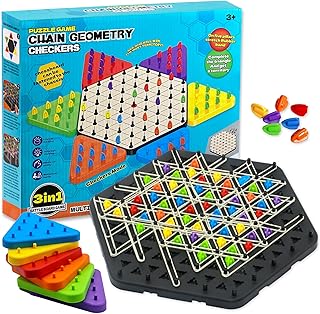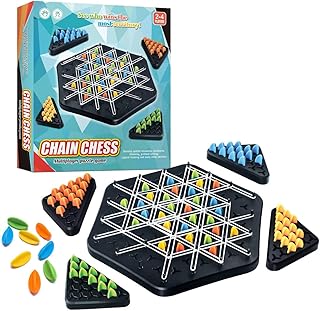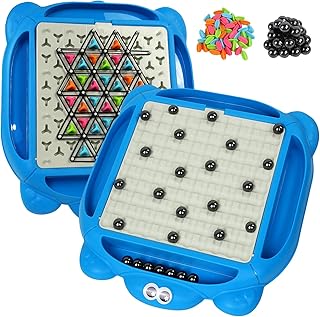The Chain Triangle Chess Game, often marketed as "Triggle" or simply "Chain Triangle Chess," is an engaging strategy board game that combines elements of territory control, geometry, and tactical thinking.
Emerging as a popular family pastime in recent years, this game transforms a simple triangular grid into a battlefield where players use elastic bands or rubber ropes to enclose spaces and claim victory.
It's designed for 2 to 4 players, making it versatile for small gatherings or larger groups, and appeals to kids aged 8 and up, as well as adults seeking a quick yet challenging diversion.
With its emphasis on spatial reasoning and forward planning, it's often compared to classics like Blokus or Go, but with a unique rubber-band mechanic that adds a tactile, hands-on flair.
Products bearing this name started popping up on e-commerce platforms like Amazon and Walmart around 2024, often manufactured in China and distributed globally.
The game draws from concepts like triangular tessellations—patterns of equilateral triangles that tile a plane—and incorporates elastic elements for dynamic play.
Key components include:
Board: A flat, hexagonal or triangular grid made of durable plastic or wood, featuring pegs or pillars arranged in a pattern that allows for triangle formation. The grid usually has multiple rows, creating dozens of potential triangular spaces.
Elastic Bands or Rubber Ropes: These are the "chains" of the game—stretchy bands in different colors (one for each player) used to connect pillars and enclose triangles.
Player Pieces: Small tokens, discs, or chess-like figures (often in shapes like pawns or abstract markers) that players place inside completed triangles to claim them.
Pillars or Pegs: Fixed or insertable posts around which bands are looped to form the sides of triangles.
Optional Accessories: Some versions include a timer for speed rounds, scorecards, or expansion packs for larger boards.
Here's a step-by-step breakdown of the basic rules (variations may exist depending on the manufacturer):
Setup:
Place the board in the center of the play area.
Each player chooses a color and receives an equal number of elastic bands (typically 10–15 per player) and pieces.
Divide the pillars if they're removable, or use the pre-set grid.
Turn Structure:
Players take turns in clockwise order.
On your turn, select one elastic band and stretch it between two (or more, depending on rules) pillars to form or contribute to a triangle. Some versions allow connecting multiple pillars in a chain.
If your band completes a closed triangle (all three sides enclosed), you immediately place one of your pieces inside it to claim it. A triangle can only be claimed if it's fully formed on your turn—no stealing incomplete ones.
Advanced rules might allow "chaining" multiple triangles in one turn if your band closes several at once, earning bonus points.
Special Mechanics:
Blocking: You can place bands to block opponents from completing their triangles, adding a defensive layer.
Multi-Triangle Chains: In some variants, forming a chain of connected triangles lets you place pieces in all of them, amplifying your score.
Player Limits: For 2 players, focus on direct opposition; for 4, alliances or free-for-alls can emerge organically.
Winning the Game:
Play continues until all bands are used or no more triangles can be formed.
Count the number of claimed triangles (or pieces placed). The player with the most wins. Ties can be broken by the size of the largest connected chain of triangles.
A full game lasts 15–30 minutes, making it ideal for quick sessions. For younger players, simplify by ignoring blocking rules; for experts, add time limits per turn to ramp up the pressure.Strategies for SuccessChain Triangle Chess rewards foresight and adaptability.
Key tips include:
Early Expansion: Start by claiming small, isolated triangles to build a point lead, then connect them into larger chains.
Defensive Play: Monitor opponents' potential closures and place bands to disrupt them—sometimes sacrificing a turn to block is worth it.
Geometric Efficiency: Understand triangle geometry; equilateral setups allow for denser packing, maximizing your enclosures.
Endgame Focus: As bands dwindle, prioritize high-value chains over single triangles.
Player Dynamics: In multiplayer games, form temporary alliances to gang up on the leader, but be ready to betray for the win.
The game's depth comes from its emergent complexity—simple rules lead to intricate board states, much like chess middlegames.Benefits and Educational ValueBeyond entertainment, Chain Triangle Chess offers numerous developmental perks:
Cognitive Skills: Enhances spatial reasoning, pattern recognition, and strategic planning—perfect for STEM education.
Social Interaction: Encourages communication, negotiation (in team variants), and sportsmanship.
Fine Motor Development: Handling elastic bands builds dexterity, especially for kids.
Inclusivity: Accessible for various ages and abilities; color-blind friendly versions use patterns instead of hues.
Therapeutic Aspects: The rhythmic stretching and snapping can be relaxing, making it a mindfulness tool disguised as play.
Educators often use it in classrooms to teach geometry basics, like triangle properties and tessellation, while families appreciate its screen-free bonding potential.Variations and ExpansionsTo keep things fresh, try these twists:
Themed Boards: Some sets feature fantasy or sci-fi themes, with pieces as knights or spaceships.
Giant Outdoor Version: Use larger pegs and ropes for backyard play.
Digital Adaptations: While primarily physical, apps simulating similar mechanics (like triangle-based puzzles) exist for solo practice.
Custom Rules: Introduce "power bands" that allow skipping turns or removing opponent pieces.
If you're crafty, DIY a version with a pegboard, rubber bands, and coins as pieces.
The Chain Triangle Chess Game is a refreshing entry in the strategy genre, blending physical interaction with mental acuity. Whether you're a chess enthusiast looking for a geometric spin or a parent seeking an educational toy, it's a worthwhile addition to any game collection. Easy to learn but hard to master, it promises hours of triangular triumphs and strategic showdowns. Grab a set, stretch those bands, and dive into the chain reaction of fun!
 |  |  |
 |  |  |
